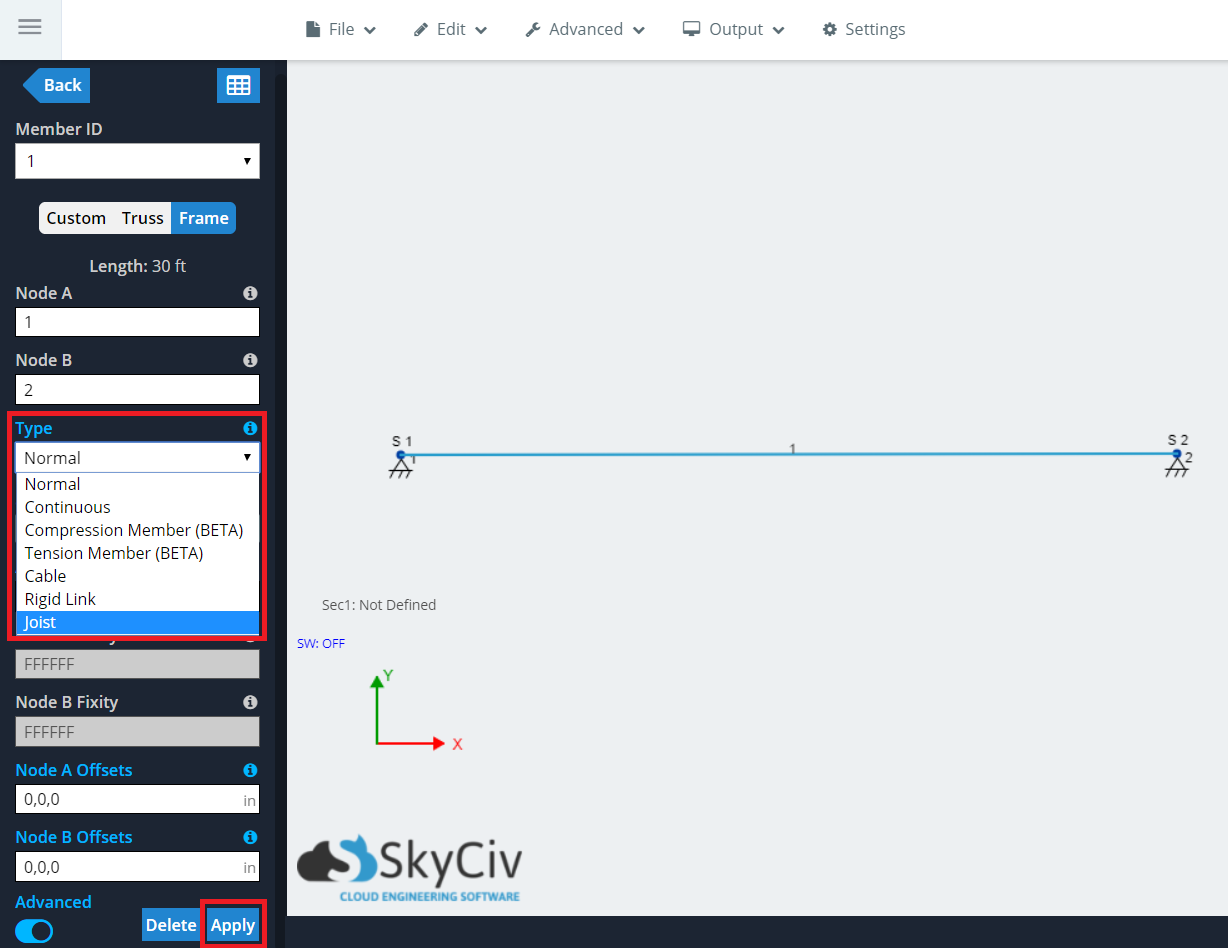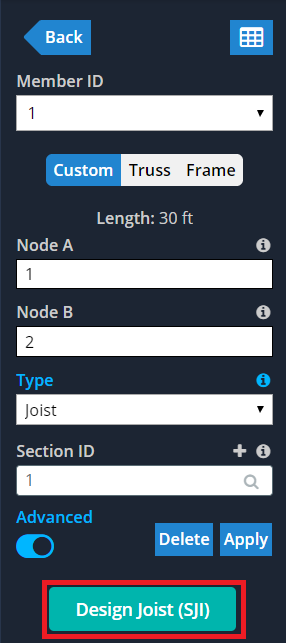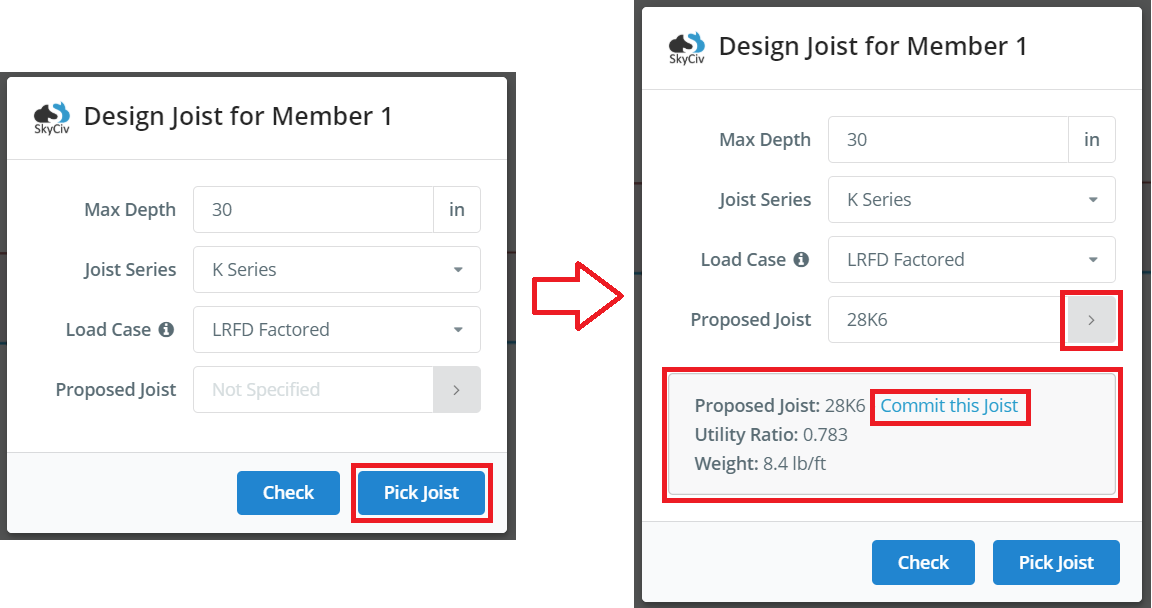Quickly select and check Open Web Steel Joists (OWSJ) from the Steel Joist Institute (SJI) Load Tables
Open Web Steel Joists are commonly used, especially in the United States, thanks to their high strength-to-weight ratio compared to other structural materials and elements. SkyCiv gives users the ability to identify members and quickly check capacity from a variety of series outlined by SJI’s Load Tables.
SJI Joist Series currently supported:
- K-Series
- LH-Series
- DLH-Series
SkyCiv Structural 3D currently supports the design of joists in accordance with the Standard Load Tables¹. Subsequently, joists may only be designed if experiencing a Uniform Distributed Load (UDL). If any other load type or variation is used, Structural 3D will generate a error message.
Note: Structural 3D will pick and check joist sizes using the TOTAL safe (factored or unfactored) uniformly distributed load-carrying capacities (black values in the SJI Standard Load Tables).
Note: When selecting the Joist member type, Structural 3D will force the corresponding end fixities (FFFRRR) so that it can run the analysis
What is happening in Structural 3D?
Members in Structural 3D act as extruded sections identified in the Section Builder. The Standard Load tables presented by SJI Therefore, because joist cross-sections vary along their length, SkyCiv uses the Virtual Joist library to estimate the properties of each joist designation.
Structural 3D will pick the correct joist size based on the series selected, member span, and UDL magnitude. Then it will find the closest corresponding Virtual Joist to fill out the remaining section properties so that the structural analysis can run. Because of the limitations on analysis, the joist should not be experiencing any resultant lateral forces.
How to Design a OWSJ in Structural 3D & Example
Find the member you want to design, and turn on the ‘Advanced’ settings. Change the member ‘Type’ to ‘Joist’ and hit ‘Apply’. Some fields will be consolidated (such as end fixities)

Apply a load such that the resultant load is a UDL.

Click on ‘Design Joist (SJI)’ button to bring up the design window:

Impose a depth limit, select the series, identify the load case, and click on ‘Pick Joist’. The chosen joist will show up along with the unity ratio. To commit that joist to your member, either click on the blue ‘Commit Changes’ text or the gray arrow to the right of the field.
Note: If there are no suitable joists or the member is experiencing a variation in load, you will receive an error.

The subsequent joist selection and virtual joist representation will be brought into the project as a section and directly applied to that member.

Note: Joist sizes can be written in/edited and individually checked for design using the ‘Check’ button. Always make sure to commit any changes to the joist size to bring it into your model.
Successful Return Values
Return values are based on the specified dimensional and load conditions of the joist in S3D.
Pick Returns: Selected joist designation, utility ratio and joist weight.
Check Returns: Proposed joist utility ratio.
Error Messages
Error messages are based on user input violation of specific criteria in the SJI loading tables. Explanation of error messages and possible solutions are provided below:
[hr style=”1″ margin=”40px 0px 40px 0px”]

Explanation: This is an error returned by the check functionality. It occurs when the joist designation input by the user to check is not present in the SJI load tables for the span specified in S3D.
Possible Solutions:
- Check that your proposed joist designation has been inputted correctly and in the correct format, specifically that the joist series is inputted as a CAPITAL letter (K, LH, DLH vs k, lh, dlh)
- Check that your proposed joist is available for that joist span in the SJI load tables. If not then select a valid joist for the given span.
[hr style=”1″ margin=”40px 0px 40px 0px”]
![]()
Explanation: This is an error returned by the pick functionality. A valid joist cannot be selected from the SJI loading tables. It occurs when applied loading conditions exceed the maximum safe applicable load for the proposed joist characteristics.
Possible Solutions:
- Check that you are selecting the correct joist series. Generally, K-series joists are the msot economical. Longer spans will require LH and DLH joists.
- Check if maximum depth could be increased. This will allow a greater safe applied load in the joist.
- Check if your load case is correct. Designs based on ASD and LRFD can produce significantly different results, especially Factored vs. Unfactored.
- Check that the magnitude and units of your applied load is correct and intended.
[hr style=”1″ margin=”40px 0px 40px 0px”]

Explanation: This is an error returned by the check functionality. It occurs when the applied load is too large for the specified joist and load case – anything over 1.0 is a fail.
Possible Solutions:
- Check that the intended joist designation was inputted correctly.
- Check if your load case is correct. Designs based on ASD and LRFD can produce significantly different results, especially Factored vs. Unfactored.
- Check that the magnitude and units of your applied load is correct and intended.
[hr style=”1″ margin=”40px 0px 40px 0px”]

Explanation: This is an error returned by the pick functionality. It occurs when the proposed maximum depth of the joist is too small for the selected joist span and load case.
Possible Solutions:
- Check that the magnitude of the depth limit is correct and intended.
- Check the value of the joist’s spans in S3D. Larger spans lengths require larger depths to be structurally viable.
- Check if your load case is correct. Designs based on ASD and LRFD can produce significantly different results, especially Factored vs. Unfactored.
References:
- Standard Specifications for K-Series, LH-Series, DLH-Series Open Web Steel Joists and for Joist Girders. SJI 100 (44th ed.). Florence, SC: Steel Joist Institute. 2015.

